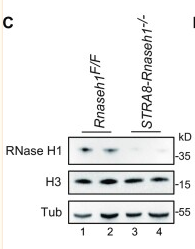RNase H1 Antibody - #DF12084
| Product: | RNase H1 Antibody |
| Catalog: | DF12084 |
| Description: | Rabbit polyclonal antibody to RNase H1 |
| Application: | WB IHC IF/ICC |
| Cited expt.: | WB, IF/ICC |
| Reactivity: | Human, Mouse, Rat |
| Prediction: | Pig, Zebrafish, Bovine, Horse, Sheep, Rabbit, Dog, Xenopus |
| Mol.Wt.: | 32 kDa; 32kD(Calculated). |
| Uniprot: | O60930 |
| RRID: | AB_2844889 |
Related Downloads
Protocols
Product Info
*The optimal dilutions should be determined by the end user. For optimal experimental results, antibody reuse is not recommended.
*Tips:
WB: For western blot detection of denatured protein samples. IHC: For immunohistochemical detection of paraffin sections (IHC-p) or frozen sections (IHC-f) of tissue samples. IF/ICC: For immunofluorescence detection of cell samples. ELISA(peptide): For ELISA detection of antigenic peptide.
Cite Format: Affinity Biosciences Cat# DF12084, RRID:AB_2844889.
Fold/Unfold
H1RNA; MGC108918; Ribonuclease H type II; RibonucleaseH1; RNaseH1; RNH1;
Immunogens
A synthesized peptide derived from human RNase H1, corresponding to a region within the internal amino acids.
- O60930 RNH1_HUMAN:
- Protein BLAST With
- NCBI/
- ExPASy/
- Uniprot
MSWLLFLAHRVALAALPCRRGSRGFGMFYAVRRGRKTGVFLTWNECRAQVDRFPAARFKKFATEDEAWAFVRKSASPEVSEGHENQHGQESEAKASKRLREPLDGDGHESAEPYAKHMKPSVEPAPPVSRDTFSYMGDFVVVYTDGCCSSNGRRRPRAGIGVYWGPGHPLNVGIRLPGRQTNQRAEIHAACKAIEQAKTQNINKLVLYTDSMFTINGITNWVQGWKKNGWKTSAGKEVINKEDFVALERLTQGMDIQWMHVPGHSGFIGNEEADRLAREGAKQSED
Predictions
Score>80(red) has high confidence and is suggested to be used for WB detection. *The prediction model is mainly based on the alignment of immunogen sequences, the results are for reference only, not as the basis of quality assurance.
High(score>80) Medium(80>score>50) Low(score<50) No confidence
Research Backgrounds
Endonuclease that specifically degrades the RNA of RNA-DNA hybrids. Plays a role in RNA polymerase II (RNAp II) transcription termination by degrading R-loop RNA-DNA hybrid formation at G-rich pause sites located downstream of the poly(A) site and behind the elongating RNAp II.
Cytoplasm.
Ubiquitous.
Belongs to the RNase H family.
Research Fields
· Genetic Information Processing > Replication and repair > DNA replication.
References
Application: IF/ICC Species: Mouse Sample:
Application: WB Species: Mouse Sample:
Restrictive clause
Affinity Biosciences tests all products strictly. Citations are provided as a resource for additional applications that have not been validated by Affinity Biosciences. Please choose the appropriate format for each application and consult Materials and Methods sections for additional details about the use of any product in these publications.
For Research Use Only.
Not for use in diagnostic or therapeutic procedures. Not for resale. Not for distribution without written consent. Affinity Biosciences will not be held responsible for patent infringement or other violations that may occur with the use of our products. Affinity Biosciences, Affinity Biosciences Logo and all other trademarks are the property of Affinity Biosciences LTD.










